Evaluating Virtual Reality in Education: An Analysis of VR through the Instructors’ Lens
Abstract
1. Introduction
2. Related Work
3. The Rationale and Justification for the Research Approach
- RQ1: What is the current state of the art in commercial collaborative VR applications for educational activities?
- –
- What are the features provided by commercial applications to support instructional activities?
- RQ2: How do current commercial collaborative VR applications meet the expectations of educators to conduct teaching activities?
- –
- What are the software requirements from the point of view of instructors?
- –
- How do instructors perceive the usability of these selected applications?
- –
- Barriers to adoption: What are the challenges perceived by instructors for deploying VR in classrooms?
4. Methodology
4.1. Participants
4.2. Phases
4.2.1. Application Search and Selection
- Inclusion criteria
- Shared collaborative space available for learning activities.
- Exclusion criteria
- Does not support the HMDs selected for the study;
- Free license not available;
- Limited to a certain subject (e.g., chemistry or anatomy).
4.2.2. Initial Needs Assessment
4.2.3. Application Walkthrough
4.2.4. Hands-On Immersive Experience
4.3. Data Analysis
5. Results
5.1. Participants’ Technology Usage and Current Teaching Methods
5.2. Participants’ Prior VR Experiences
5.3. Expectations for Teaching a VR Course
5.4. Usability Assessment
5.5. Themes of Requirements
5.5.1. Need for 2D Media
5.5.2. Need for 3D Media
5.5.3. Need for Immersive and Interactive Experience
5.5.4. Social Collaboration
5.5.5. User-Centric Design
5.5.6. Need for Instructional Support
5.6. Themes of Barriers to Adoption
5.6.1. Attitude Toward Technology
5.6.2. Learner’s Experience
5.6.3. Technology Deficiency
5.6.4. Expertise and Effort Concerns
5.6.5. Logistics
5.7. Themes of Satisfaction and Dissatisfaction
5.7.1. Dissatisfaction with Unfulfilling Experience
5.7.2. Dissatisfaction with Non-Intuitiveness
5.7.3. Satisfaction with Immersive Experience
5.7.4. Satisfaction with Fulfilling Experiences
6. Discussion
- Attitude toward technology directly correlates with RQ2: “How do current commercial collaborative VR applications meet the expectations of educators to conduct teaching activities?” This trend substantially addresses the sub-question regarding instructors’ perceptions of the usability of these applications. Many participants expressed skepticism about the added value of VR over traditional methods, which often reflects a cautious attitude toward adopting new technologies without clear pedagogical benefits.
- Expertise and effort concerns reflect the practical challenges instructors face, which ties back into RQ2’s sub-question about the barriers to VR adoption in classrooms. The significant effort required to develop and implement VR content, coupled with a lack of requisite skills among instructors, highlights critical obstacles that need addressing for VR to become a viable teaching tool.
- Technological integration and support speak to RQ1: “What is the current state of the art in commercial collaborative VR applications for educational activities?” This trend delves into the existing features of VR applications that support instructional activities, and it also aligns with the sub-question concerning software requirements from instructors’ viewpoints. The discussion emphasized the need for VR applications to seamlessly integrate with current pedagogical practices and university systems, such as Google Drive, to enhance their utility and adoption.
7. Conclusions
Author Contributions
Funding
Institutional Review Board Statement
Informed Consent Statement
Data Availability Statement
Conflicts of Interest
Appendix A. Detailed Questionnaire Responses
- Enhance Transparency while offering readers a direct look at the data that informed our analysis and conclusions, reinforcing the validity of our study.
- Provide Context by allowing readers to see the exact nature of the feedback that participants provided, which adds depth to the summarized insights in the main text.
- Support Further Research by enabling other researchers to utilize these detailed data for secondary analysis, potentially leading to new insights or supplementary studies.
Appendix A.1. Need for 2D Media
- P06 Hands-On: “... And maybe this can be done with the screenshare, b but if it were possible to use PowerPoint rather than PDF. That would be better for presenting a lecture. Just to get the animations....There are slide transitions which are one thing, But then on the slides showing bullet point information one by one, or showing a drawing with added complexity or, or being able to annotate more sequentially....”
- P03 Hands-On: “..this is a great feature.., but completely out of fidelity compared to if I use my iPad or any other digital sketching tool, so it has low fidelity of control and customization options....”
Appendix A.2. Need for 3D Media
- P01 Hands-On: “...I mean, it was fine. But of course for my class that would not be enough, right? I do need to show them the anatomy. So just having the outside box of an animal would not be enough...”
- P04 Hands-On: “...So the 3D drawing turned out to be a lot more useful than I thought. Because a lot of time in my class, I try to draw a 3D graph especially when I teach convex optimization for graduate courses...”
Appendix A.2.1. Need for Immersive and Interactive Experience
- P35 Hands-On: “....to provide.. the experience of walking through the power plant for students. Because in most cases students just don’t have a chance to actually go to a nuclear power plant. They became nuclear engineers and they haven’t even seen the plant themselves...”
- P01 Hands-On: “....histology class..it would be amazing for them if they could go through the layers of the skin. We studied this kinda macroscopic aspect to know how small the cells that comprise the skin are. It would be nice if they can make a voyage through the skin and actually see all these are the cells.. this is how they relate to the glands and underneath there is connective tissue...”
- P18 Walkthrough: “.. I remember when I was in college, that was really hard to grasp and I just thought that the people who could explain how waves hit the surface and bounced off were just incredible geniuses because it was, it was very, very hard. I think.... So any of those types of things that involve the visualization of electromagnetic fields and forces, and those types of things, I think are potentially great applications for VR.”
Appendix A.2.2. Social Collaboration
- P13 Walkthrough: “.... Like maybe there’s a Kanban board, A planning board. Again says like, well, here’s where you would do that and here are the sticky notes that you might put into the different columns of that board. We’re planning a software project!...”
- P21 Hands-On: “...I like the customizable avatars. I feel like it allows people to represent themselves in a way they want to be represented and viewed, even virtually, as they want to be viewed........ to bring in their own personality into the engineering environment...”
- P13 Hands-On: “....looks a little creepy that the student doesn’t have any legs.. other than that...I’m also not sure if you have pupils. The way these avatars move is the creepiest thing..”
Appendix A.2.3. User-Centric Design
- P40 Hands-On: “....Yeah, I think I did like having the menu or tablets to be able to control in that way, well just felt a little more natural to me for controlling what was on the big screen or in the room...”
- P34 Hands-On: “.... Although when I first started it up, it said there was an option for voice commands. I would like to know more about that as an option for students for accessibility...”
Appendix A.2.4. Need for Instructional Support
- P33 Hands-On: “...But maybe if I did that, I want to record this movement because I’m going to teach maybe another class next term or you know I’d like to save some of this stuff. You start putting in work and more work and more work and getting everything just right. You don’t want to do that every term...”
- P02 Hands-On: “..one thing that did come to mind is the interface with Canvas (LMS) versus the other platform that’s outlined. So for people at OSU to adopt something like this, the likelihood of adoption is going to be way higher if it’s integrated with Canvas, than if you have to go to another platform...”
Appendix A.2.5. Attitude Toward Technology
- P21 Hands-On: “....I can just show videos in my classroom without a headset... Don’t need VR for that. That’s like the most expensive way to show!”
- P17 Walkthrough: “....rare and dangerous cases, use it in VR. But something like cooking spaghetti step-by-step. No, no...”
Appendix A.2.6. Learner’s Experience
- P34 Hands-On: “ I would be interested to know what it’s like as a student. Watching all of this from, from that perspective, to have a sense of whether I’d want to do this with my own students...”
- P39 Interview: “....We still need accommodations for students who simply cannot do immersive VR..... it’s a positive experience and it will be quite useful in the future, but it cannot be the only way...”
Appendix A.2.7. Technology Deficiency
- P33 Hands-On: “.....One thing is that the headset keeps falling down all the time. I need to tighten it.....”
- P01 Hands-On: “....I think like me there are many people, especially older, right?... young people don’t mind. But as you get older it is bothering me. so I wish that they can manufacture something that is lighter, more comfortable.....”
- P18 Hands-On: “....The jitter factor kind of influences my experience, which.., I was glad when we were done because it was really hard for me. And maybe it’s just getting used to the headsets or the glasses....”
- P05 Hands-On: “....(after removing the headset) I actually got a little dizzy. But I am ok.....”
Appendix A.2.8. Expertise and Effort Concerns
- P39 Walkthrough: “...I was thinking, yeah, good idea but...where do I get all this content?..... Do I have to generate those content or..(is the). Is content already available?..that’s the biggest question because that’s going to cost a lot..”
- P01 Hands-On: “....So it’s blank now.. what did I do..I did something bad.. (the participant accidentally clicked on the wrong button) I went back..... I am sorry..”
- P34 Hands-On: “.....Now that I see where the typing actually is.. am I doing it wrong? I will start over. The other letters flow out in front of me, I guess....”
- P34 Hands-On: “....Definitely a little bit tiring, and maybe that gets better over time.. with practice....”
Appendix A.2.9. Logistics
- P03 Hands-On: “...Also, there’s another debate... Maybe we can ask students if they are interested in buying those? Just a ten-minute experience in a classroom and purely in my point of view for visualization purposes.. Yes or no, right? Many privileged students will probably do it in a heartbeat, but still that’s coming from financially strict, you know, parts of the country or geography or economical class, they will have a challenging time.Just buying those..”
- P40 Hands-On: “.....I’m still struggling a little bit with how I would incorporate it feasibly to my in-person class. I’m interested in learning how I might be able to actually make that work for perhaps specific modules or specific topics...”
Appendix A.2.10. Dissatisfaction with Unfulfilling Experience
- P04 Hands-On: “... Alright, so this is a lot harder...So I’m trying to draw a graph... So when I move the hand at the end, can you see my cursor?... when I release it.. [extra line added when participant releases the controller] it automatically moves, draws the line... I would like to get something more like a hand drawing.. this motion is.. not natural...”
- P05 Hands-On: “Uh.. come on!... I can’t really draw with these controllers. It’s not like using my hands. I mean... the thing I drew here is gibberish..”
Appendix A.2.11. Dissatisfaction with Non-Intuitiveness
- P34 Hands-On: “... No, it’s not because how do I keep moving it okay.... It is not doing that now.... Okay. Now I can’t.... How did we do that before?... Alright, I am not sure how that works.... It seems to intermittently respond or else I’m going around.... Maybe it’s a toggle. I think it’s a toggle!!...”
- P40 Hands-On: “...[participant accidentally teleported while trying to grab model] I messed up!.... [Participant accidentally teleported somewhere and can’t locate herself] oh! where did I go.. I went behind the hall!...”
- P13 Hands-On: “..it feels like each time I go into a new app I have to relearn everything. And then all of it is new to me... That’s frustrating. I’m sweating.. because it’s freaking me out so much..! The stress of trying to figure out how to interact. Well, people are watching you as well... ”
- P01 Hands-On: “.....If I am typing, it should show what I am typing right..? (search functionality: text not clearly visible)...”
Appendix A.2.12. Satisfaction with Immersive Experience
- P17 Hands-On: “...I feel like in a chemistry lab, you know, that classroom, back in the.... Okay. Well, yeah, yes. We have many classrooms like this on campus....”
- P39 Hands-On: “...And then with the lecture hall that you have there, if it’s still, I think it gives students a sense of I’m in the classroom. So at least my experience is that when students don’t feel it in the classroom, the learning doesn’t quite go hand in hand. It’s just, I don’t know. They have been trained to be students for too long that that is ingrained. So the lecture hall gives that feeling...”
Appendix A.2.13. Satisfaction with Fulfilling Experiences
- P02 Hands-On: “..Just the novelty of the 3D drawing in front of my face to be able to show people. And just because it’s not the, the 2D on the white board, it feels like it would be more interactive and more attractive to whoever you’re dealing with...”
- P04 Hands-On: “... This time I am going to draw this..(freehand drawing) Okay, This is definitely better than the other (using controllers to draw at a distance) because I can feel that I can control it...”
- P33 Hands-On: “....I liked it. I was kinda surprised that I liked it as much as I did. That was enjoyable and I can see myself getting very creative with some of those things like primitives..”
References
- Helms, J.L. Comparing Student Performance in Online and Face-to-face Delivery Modalities. J. Asynchronous Learn. Netw. 2014, 18, n1. [Google Scholar] [CrossRef]
- Phirangee, K. Students’ Perceptions of Learner-Learner Interactions that Weaken a Sense of Community in an Online Learning Environment. Online Learn. 2016, 20, 13–33. [Google Scholar] [CrossRef]
- Arnseth, H.C. Activity theory and situated learning theory: Contrasting views of educational practice. Pedagog. Cult. Soc. 2008, 16, 289–302. [Google Scholar] [CrossRef]
- Wilson, J.M.; Goodman, P.S.; Cronin, M.A. Group learning. Acad. Manag. Rev. 2007, 32, 1041–1059. [Google Scholar] [CrossRef]
- Wilkins, J.L.M. The relationship among elementary teachers’ content knowledge, attitudes, beliefs, and practices. J. Math. Teach. Educ. 2008, 11, 139–164. [Google Scholar] [CrossRef]
- Lin, C.H.; Sumardani, D. Transitioning to virtual reality learning in 5E learning model: Pedagogical practices for science learning. Interact. Learn. Environ. 2023, 1–15. [Google Scholar] [CrossRef]
- Suri, P.A.; Syahputra, M.E.; Amany, A.S.H.; Djafar, A. Systematic literature review: The use of virtual reality as a learning media. Procedia Comput. Sci. 2023, 216, 245–251. [Google Scholar] [CrossRef]
- Li, Y.; Ying, S.; Chen, Q.; Guan, J. An Experiential Learning-Based Virtual Reality Approach to Foster Students’ Vocabulary Acquisition and Learning Engagement in English for Geography. Sustainability 2022, 14, 15359. [Google Scholar] [CrossRef]
- McClannon, T.W.; Cheney, A.; Bolt, L.; Terry, K. Predicting Sense of Presence and Sense of Community in Immersive Online Learning Environments. Online Learn. 2018, 22, 141–159. [Google Scholar] [CrossRef]
- Peterson, A.T.; Beymer, P.N.; Putnam, R.T. Synchronous and Asynchronous Discussions: Effects on Cooperation, Belonging, and Affect. Online Learn. 2018, 22, 7–25. [Google Scholar] [CrossRef]
- Picciano, A.G. Beyond student perceptions: Issues of interaction, presence, and performance in an online course. Online Learn. 2002, 6, 21–40. [Google Scholar] [CrossRef]
- Won, M.; Ungu, D.A.K.; Matovu, H.; Treagust, D.F.; Tsai, C.C.; Park, J.; Mocerino, M.; Tasker, R. Diverse approaches to learning with immersive Virtual Reality identified from a systematic review. Comput. Educ. 2023, 195, 104701. [Google Scholar] [CrossRef]
- Henstrom, J.; De Amicis, R.; Sanchez, C.A.; Turkan, Y. Immersive engineering instruction: Using Virtual Reality to enhance students’ experience in the classroom. Comput. Graph. 2024, 121, 103944. [Google Scholar] [CrossRef]
- Henstrom, J.; De Amicis, R.; Sanchez, C.; Demirel, O. VR Technical Drawing Learning Activity for College Engineering Students: Design, Development and Evaluation. In Proceedings of the Design Tools and Methods in Industrial Engineering III, Florence, Italy, 6–8 September 2023; Carfagni, M., Furferi, R., Di Stefano, P., Governi, L., Gherardini, F., Eds.; Springer: Cham, Switzerland, 2024; pp. 397–404. [Google Scholar]
- Johnson-Glenberg, M.C. Embodied Education in Mixed and Mediated Realties. In Virtual, Augmented, and Mixed Realities in Education; Springer: Singapore, 2017; pp. 193–217. [Google Scholar] [CrossRef]
- Linnes, C.; Ronzoni, G.; Agrusa, J.; Lema, J. Emergency Remote Education and Its Impact on Higher Education: A Temporary or Permanent Shift in Instruction? Educ. Sci. 2022, 12, 721. [Google Scholar] [CrossRef]
- Pokhrel, S.; Chhetri, R. A Literature Review on Impact of COVID-19 Pandemic on Teaching and Learning. High. Educ. Future 2021, 8, 133–141. [Google Scholar] [CrossRef]
- Dubovi, I. Learning with virtual reality simulations: Direct versus vicarious instructional experience. Interact. Learn. Environ. 2023, 31, 6627–6639. [Google Scholar] [CrossRef]
- Vega, A.V.; Madrigal, O.C.; Kugurakova, V. Approach of immersive adaptive learning for Virtual Reality simulator. In Workshop on Advanced Virtual Environments and Education (WAVE); SBC: Sao Paulo, Brazil, 2021; pp. 1–8. [Google Scholar]
- Dickerson, S.J.; Clark, R.M. A classroom-based simulation-centric approach to microelectronics education. Comput. Appl. Eng. Educ. 2018, 26, 768–781. [Google Scholar] [CrossRef]
- Lampropoulos, G.; Kinshuk. Virtual reality and gamification in education: A systematic review. Educ. Technol. Res. Dev. 2024, 2024, 1–95. [Google Scholar] [CrossRef]
- Iacono, S. Augmented Learning: Case Study of Gamified and Extended Reality Courses. Eng. Proc. 2023, 38, 13. [Google Scholar] [CrossRef]
- Falah, J.; Wedyan, M.; Alfalah, S.F.M.; Abu-Tarboush, M.; Al-Jakheem, A.; Al-Faraneh, M.; Abuhammad, A.; Charissis, V. Identifying the Characteristics of Virtual Reality Gamification for Complex Educational Topics. Multimodal Technol. Interact. 2021, 5, 53. [Google Scholar] [CrossRef]
- Riemann, T.; Kreß, A.; Roth, L.; Metternich, J.; Grell, P. Approach for Conceptualization and Implementation of Virtual Reality in Learning Factories. In Proceedings of the Conference on Learning Factories (CLF), Enschede, The Netherlands, 17–19 April 2024. [Google Scholar]
- Marougkas, A.; Troussas, C.; Krouska, A.; Sgouropoulou, C. Virtual Reality in Education: A Review of Learning Theories, Approaches and Methodologies for the Last Decade. Electronics 2023, 12, 2832. [Google Scholar] [CrossRef]
- Chen, C. Theoretical Bases for Using Virtual Reality in Education. Themes Sci. Technol. Educ. 2009, 2, 71–90. [Google Scholar]
- Dalgarno, B.; Lee, M.J. What are the learning affordances of 3-D virtual environments? Br. J. Educ. Technol. 2010, 41, 10–32. [Google Scholar] [CrossRef]
- Freina, L.; Ott, M. A Literature Review on Immersive Virtual Reality in Education: State Of The Art and Perspectives. In Proceedings of the 11th International Conference eLearning and Software for Education, Bucharest, Rumunia, 23 April 2015. [Google Scholar] [CrossRef]
- Huang, H.M.; Rauch, U.; Liaw, S.S. Investigating learners’ attitudes toward virtual reality learning environments: Based on a constructivist approach. Comput. Educ. 2010, 55, 1171–1182. [Google Scholar] [CrossRef]
- Radianti, J.; Majchrzak, T.A.; Fromm, J.; Wohlgenannt, I. A systematic review of immersive virtual reality applications for higher education: Design elements, lessons learned, and research agenda. Comput. Educ. 2020, 147, 103778. [Google Scholar] [CrossRef]
- Burtner, J. The use of discriminant analysis to investigate the influence of non-cognitive factors on engineering school persistence. J. Eng. Educ. 2005, 94, 335–338. [Google Scholar] [CrossRef]
- Ai-Lim Lee, E.; Wong, K.W.; Fung, C.C. How does desktop virtual reality enhance learning outcomes? A structural equation modeling approach. Comput. Educ. 2010, 55, 1424–1442. [Google Scholar] [CrossRef]
- Allcoat, D.; von Mühlenen, A. Learning in virtual reality: Effects on performance, emotion and engagement. Res. Learn. Technol. 2018, 26. [Google Scholar] [CrossRef]
- Gunn, F.; Kendal, M.; Mulla, M. An Exploration of How Artists Use Immersive Technologies to Promote Inclusivity, Diversity and Deep Public Engagement in Ethical Ways. In Proceedings of the EVA London 2020, BCS Learning & Development, London, UK, 6–9 July 2020; pp. 198–205. [Google Scholar]
- Di Natale, A.F.; Repetto, C.; Riva, G.; Villani, D. Immersive virtual reality in K-12 and higher education: A 10-year systematic review of empirical research. Br. J. Educ. Technol. 2020, 51, 2006–2033. [Google Scholar] [CrossRef]
- Pan, Z.; Cheok, A.D.; Yang, H.; Zhu, J.; Shi, J. Virtual reality and mixed reality for virtual learning environments. Comput. Graph. 2006, 30, 20–28. [Google Scholar] [CrossRef]
- Peterson, M. Learning interaction in an avatar-based virtual environment: A preliminary study. Paccall J. 2005, 1, 29–40. [Google Scholar]
- Laal, M.; Ghodsi, S.M. Benefits of collaborative learning. Procedia Soc. Behav. Sci. 2012, 31, 486–490. [Google Scholar] [CrossRef]
- Laal, M.; Laal, M. Collaborative learning: What is it? Procedia Soc. Behav. Sci. 2012, 31, 491–495. [Google Scholar] [CrossRef]
- Nam, C.W.; Zellner, R.D. The relative effects of positive interdependence and group processing on student achievement and attitude in online cooperative learning. Comput. Educ. 2011, 56, 680–688. [Google Scholar] [CrossRef]
- Smith, B.; MacGregor, J. What is Collaborative Learning? Wash Cent News 1993, 7, 25–29. [Google Scholar]
- Zheng, L.; Xie, T.; Liu, G. Affordances of Virtual Reality for Collaborative Learning. In Proceedings of the 2018 International Joint Conference on Information, Media and Engineering (ICIME), Osaka, Japan, 12–14 December 2018; pp. 6–10. [Google Scholar] [CrossRef]
- Bouras, C.; Guannaka, E.; Tsiatsos, T. Exploiting virtual environments to support collaborative e-learning communities. Int. J. Web-Based Learn. Teach. Technol. 2008, 3, 1–22. [Google Scholar] [CrossRef]
- Wang, P.; Wu, P.; Wang, J.; Chi, H.L.; Wang, X. A Critical Review of the Use of Virtual Reality in Construction Engineering Education and Training. Int. J. Environ. Res. Public Health 2018, 15, 1204. [Google Scholar] [CrossRef]
- Bailey, S.; Johnson, C.; Schroeder, B.; Marraffino, M. Using Virtual Reality for Training Maintenance Procedures. In Proceedings of the Interservice/Industry Training, Simulation, and Education Conference (I/ITSEC), Orlando, FL, USA, 27–30 November 2017. [Google Scholar]
- Preisman, K. Teaching Presence in Online Education: From the Instructor’s Point-of-View. Online Learn. 2014, 18, n3. [Google Scholar] [CrossRef][Green Version]
- Tate, T. How Much Does Custom Software Development Cost in 2024? 2024. Available online: https://soltech.net/how-much-does-custom-software-development-cost (accessed on 14 June 2024).
- Johnson, N.; Veletsianos, G.; Seaman, J.U.S. Faculty and Administrators’ Experiences and Approaches in the Early Weeks of the COVID-19 Pandemic. Online Learn. 2020, 24, 6–21. [Google Scholar] [CrossRef]
- Liu, D.; Bhagat, K.K.; Gao, Y.; Chang, T.W.; Huang, R. The Potentials and Trends of Virtual Reality in Education. In Virtual, Augmented, and Mixed Realities in Education; Springer: Singapore, 2017; pp. 105–130. [Google Scholar] [CrossRef]
- Thornhill-Miller, B.; Dupont, J.M. Virtual Reality and the Enhancement of Creativity and Innovation: Under Recognized Potential Among Converging Technologies? J. Cogn. Educ. Psychol. 2016, 15, 102–121. [Google Scholar] [CrossRef]
- Laurell, C.; Sandström, C.; Berthold, A.; Larsson, D. Exploring barriers to adoption of Virtual Reality through Social Media Analytics and Machine Learning—An assessment of technology, network, price and trialability. J. Bus. Res. 2019, 100, 469–474. [Google Scholar] [CrossRef]
- Chittaro, L.; Ranon, R. Web3D technologies in learning, education and training: Motivations, issues, opportunities. Comput. Educ. 2007, 49, 3–18. [Google Scholar] [CrossRef]
- Tondeur, J.; van Braak, J.; Ertmer, P.; Ottenbreit-Leftwich, A. Understanding the relationship between teachers’ pedagogical beliefs and technology use in education: A systematic review of qualitative evidence. Educ. Technol. Res. Dev. 2016, 65, 555–575. [Google Scholar] [CrossRef]
- Alalwan, N.; Cheng, L.; Al-Samarraie, H.; Yousef, R.; Ibrahim Alzahrani, A.; Sarsam, S.M. Challenges and Prospects of Virtual Reality and Augmented Reality Utilization among Primary School Teachers: A Developing Country Perspective. Stud. Educ. Eval. 2020, 66, 100876. [Google Scholar] [CrossRef]
- Ashrafzadeh, A.; Sayadian, S. University instructors’ concerns and perceptions of technology integration. Comput. Hum. Behav. 2015, 49, 62–73. [Google Scholar] [CrossRef]
- Campbell, E.; Kapp, R. Developing an integrated, situated model for digital literacy in pre-service teacher education. J. Educ. 2020, 18–30. [Google Scholar] [CrossRef]
- Viberg, O.; Mavroudi, A.; Khalil, M.; Bälter, O. Validating an Instrument to Measure Teachers’ Preparedness to Use Digital Technology in their Teaching. Nord. J. Digit. Lit. 2020, 15, 38–54. [Google Scholar] [CrossRef]
- Maderick, J.A.; Zhang, S.; Hartley, K.; Marchand, G. Preservice Teachers and Self-Assessing Digital Competence. J. Educ. Comput. Res. 2016, 54, 326–351. [Google Scholar] [CrossRef]
- Bacow, L.S.; Bowen, W.G.; Guthrie, K.M.; Long, M.P.; Lack, K.A. Barriers to Adoption of Online Learning Systems in US Higher Education; Ithaka: New York, NY, USA, 2012. [Google Scholar]
- Bolliger, D.U.; Wasilik, O. Factors influencing faculty satisfaction with online teaching and learning in higher education. Distance Educ. 2009, 30, 103–116. [Google Scholar] [CrossRef]
- McQuiggan, C.A. Faculty Development for Online Teaching as a Catalyst for Change. J. Asynchronous Learn. Netw. 2012, 16, 27–61. [Google Scholar] [CrossRef]
- Konstantinidis, A.; Tsiatsos, T.; Pomportsis, A. Collaborative virtual learning environments: Design and evaluation. Multimed. Tools Appl. 2009, 44, 279–304. [Google Scholar] [CrossRef]
- Jensen, L.; Konradsen, F. A review of the use of virtual reality head-mounted displays in education and training. Educ. Inf. Technol. 2017, 23, 1515–1529. [Google Scholar] [CrossRef]
- Velev, D.; Zlateva, P. Virtual reality challenges in education and training. Int. J. Learn. Teach. 2017, 3, 33–37. [Google Scholar]
- Gee, J.P. An Introduction to Discourse Analysis: Theory and Method, 3rd ed.; Routledge: New York, NY, USA; London, UK, 2014; selected 2–10. [Google Scholar]
- Jaccard, The Distribution of the Flora in the Alpine Zone. New Phytol. 1912, 11, 37–50. [CrossRef]
- Lisle, A.; Merenda, C.; Gabbard, J. Using affinity diagramming to generate a codebook: A case study on young military veterans and community reintegration. Qual. Res. 2019, 20, 146879411985132. [Google Scholar] [CrossRef]
- Bangor, A.; Kortum, P.; Miller, J. Determining What Individual SUS Scores Mean: Adding an Adjective Rating Scale. J. Usability Stud. 2009, 4, 114–123. [Google Scholar]
- Barrera Machuca, M.D.; Stuerzlinger, W.; Asente, P. The Effect of Spatial Ability on Immersive 3D Drawing. In Proceedings of the 2019 on Creativity and Cognition, New York, NY, USA, 23–26 June 2019; pp. 173–186. [Google Scholar] [CrossRef]
- Moore, M.G. Editorial: Three types of interaction. Am. J. Distance Educ. 1989, 3, 1–7. [Google Scholar] [CrossRef]
- Rogers, E.M.; Singhal, A.; Quinlan, M.M. Diffusion of innovations. In An Integrated Approach to Communication Theory and Research; Routledge: London, UK, 2014; pp. 432–448. [Google Scholar]
- Margaryan, A.; Littlejohn, A.; Vojt, G. Are digital natives a myth or reality? University students’ use of digital technologies. Comput. Educ. 2011, 56, 429–440. [Google Scholar] [CrossRef]
- Geszten, D.; Komlodi, A.; Hercegfi, K.; Hámornik, B.P.; Young, A.L.; Koles, M.; Lutters, W.G. A Content-Analysis Approach for Exploring Usability Problems in a Collaborative Virtual Environment. Acta Polytech. Hung. 2018, 15, 67–88. [Google Scholar]
- Nielsen, J. Usability inspection methods. In Proceedings of the Conference Companion on Human Factors in Computing Systems, Boston, MA, USA, 24–28 April 1994; pp. 413–414. [Google Scholar]
- Hooper, S.; Rieber, L.P. Teaching with Technology; Allyn and Bacon: Boston, MA, USA, 1995; pp. 154–170. [Google Scholar]
- Alzaidiyeen, N.; Mei, L.; Fong, F. Teachers’ Attitudes and Levels of Technology Use in Classrooms: The Case of Jordan Schools. Int. Educ. Stud. 2010, 3, 211–218. [Google Scholar] [CrossRef]
- Buabeng-Andoh, C. Factors influencing teachers’ adoption and integration of information and communication technology into teaching: A review of the literature. Int. J. Educ. Dev. Using Inf. Commun. Technol. 2012, 8, 136–155. [Google Scholar]
- Alfalah, S. Perceptions toward adopting virtual reality as a teaching aid in information technology. Educ. Inf. Technol. 2018, 23, 1–21. [Google Scholar] [CrossRef]
- Moser, F. Faculty Adoption of Educational Technology. EDUCAUSE Q. 2007, 30, 66. [Google Scholar]
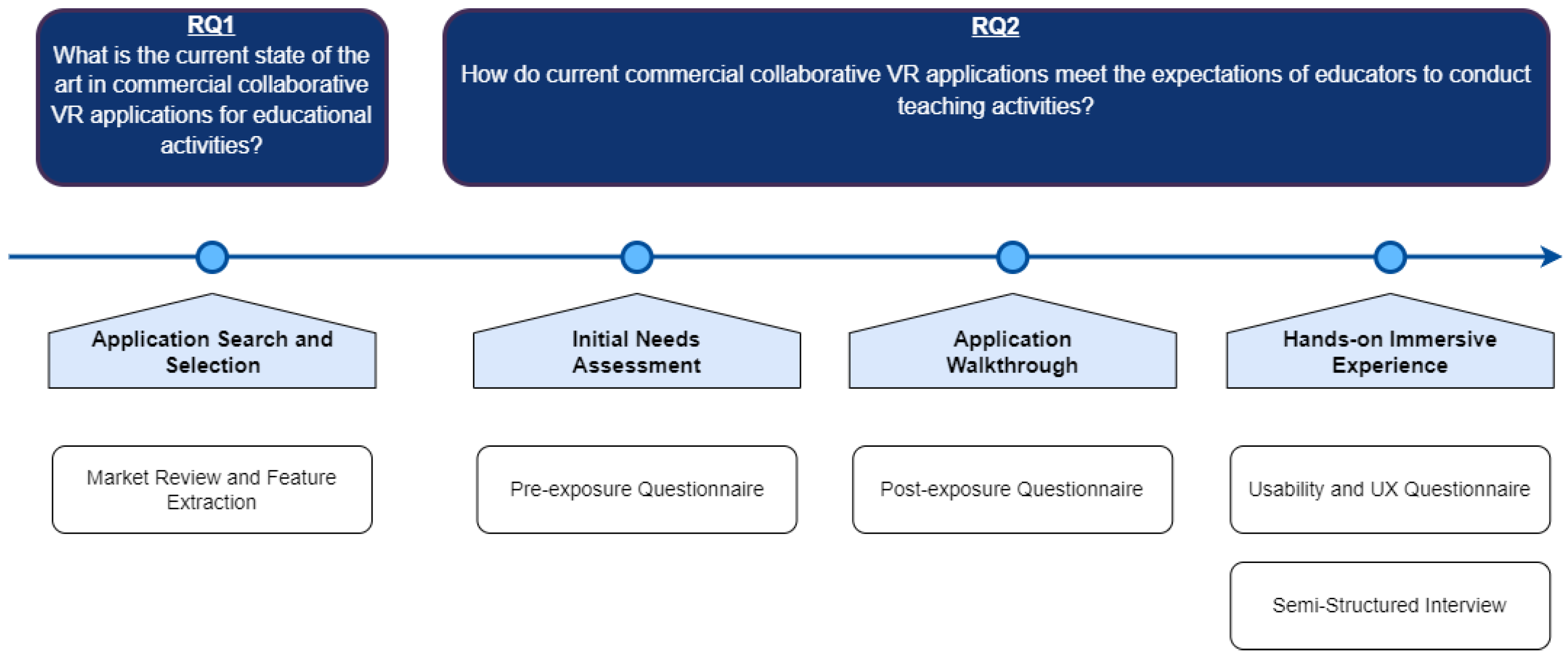
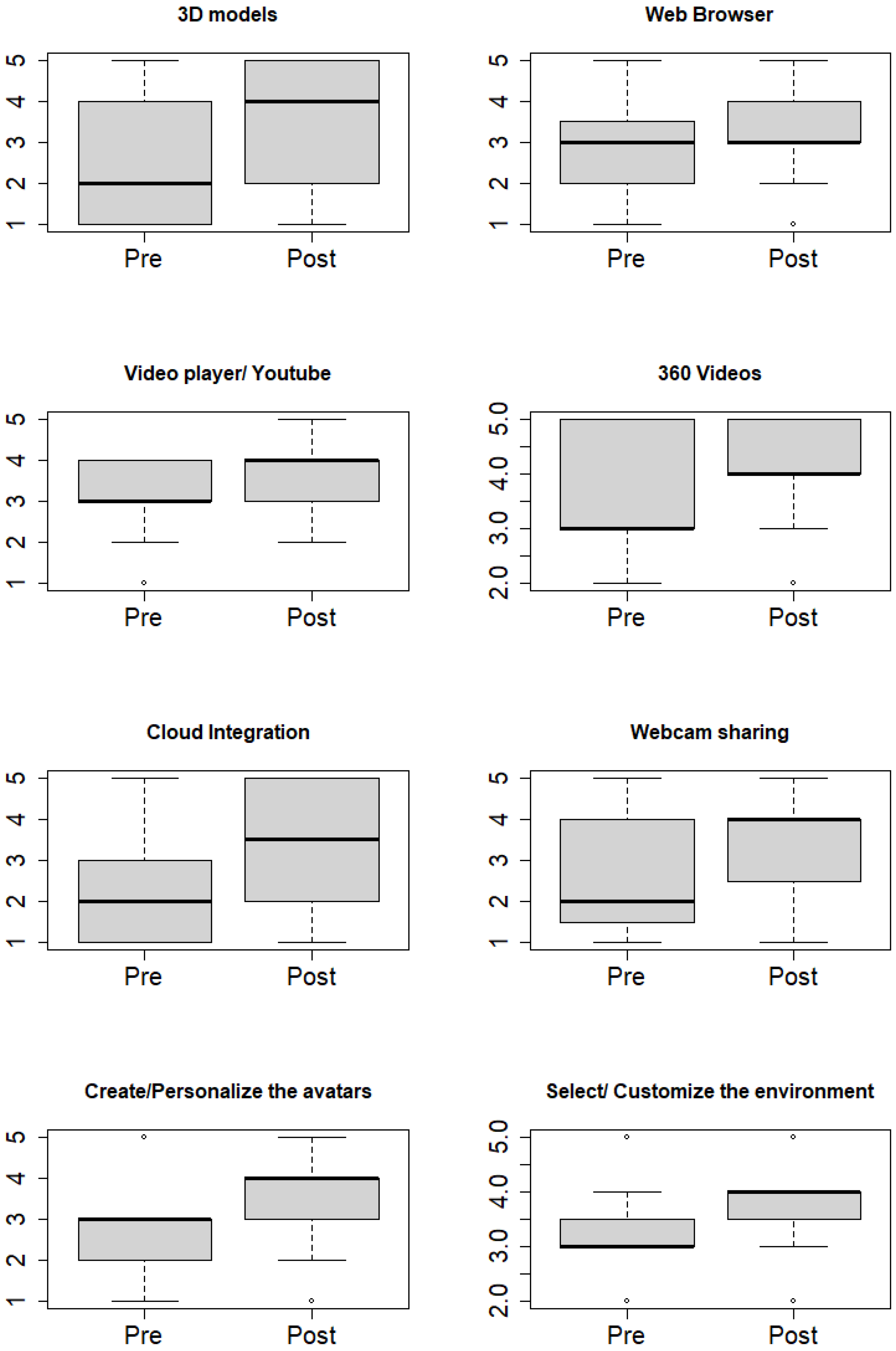
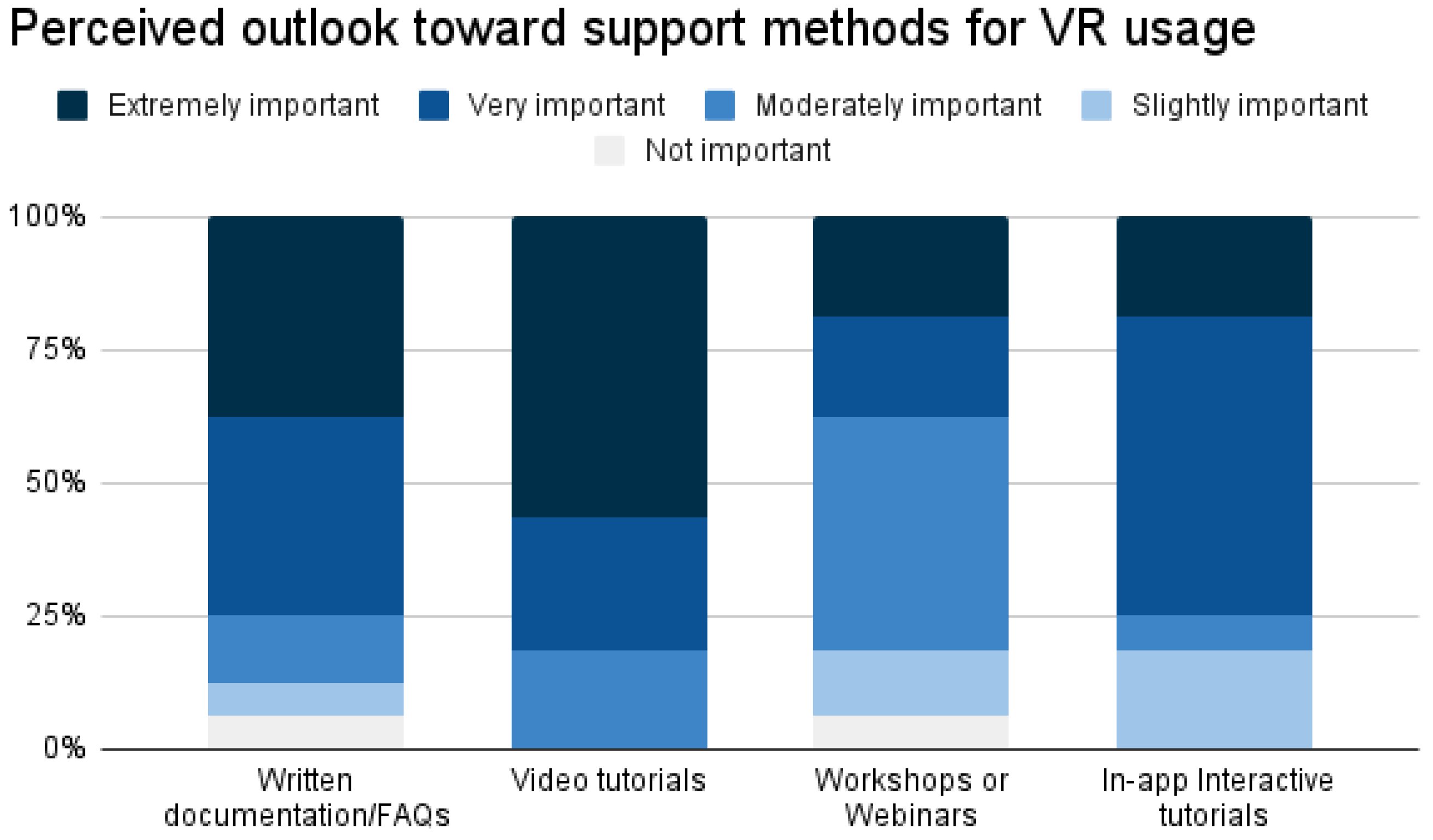

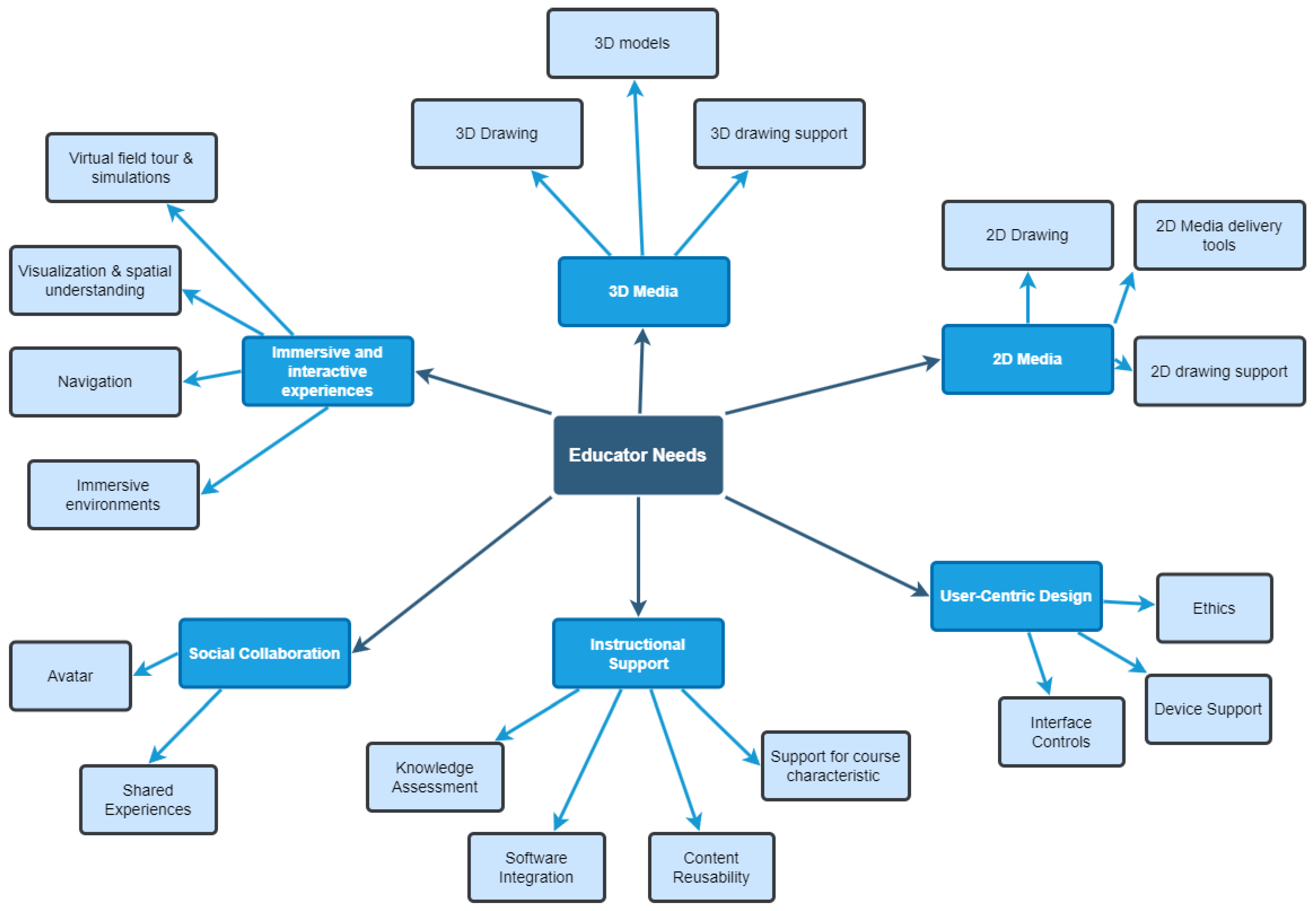
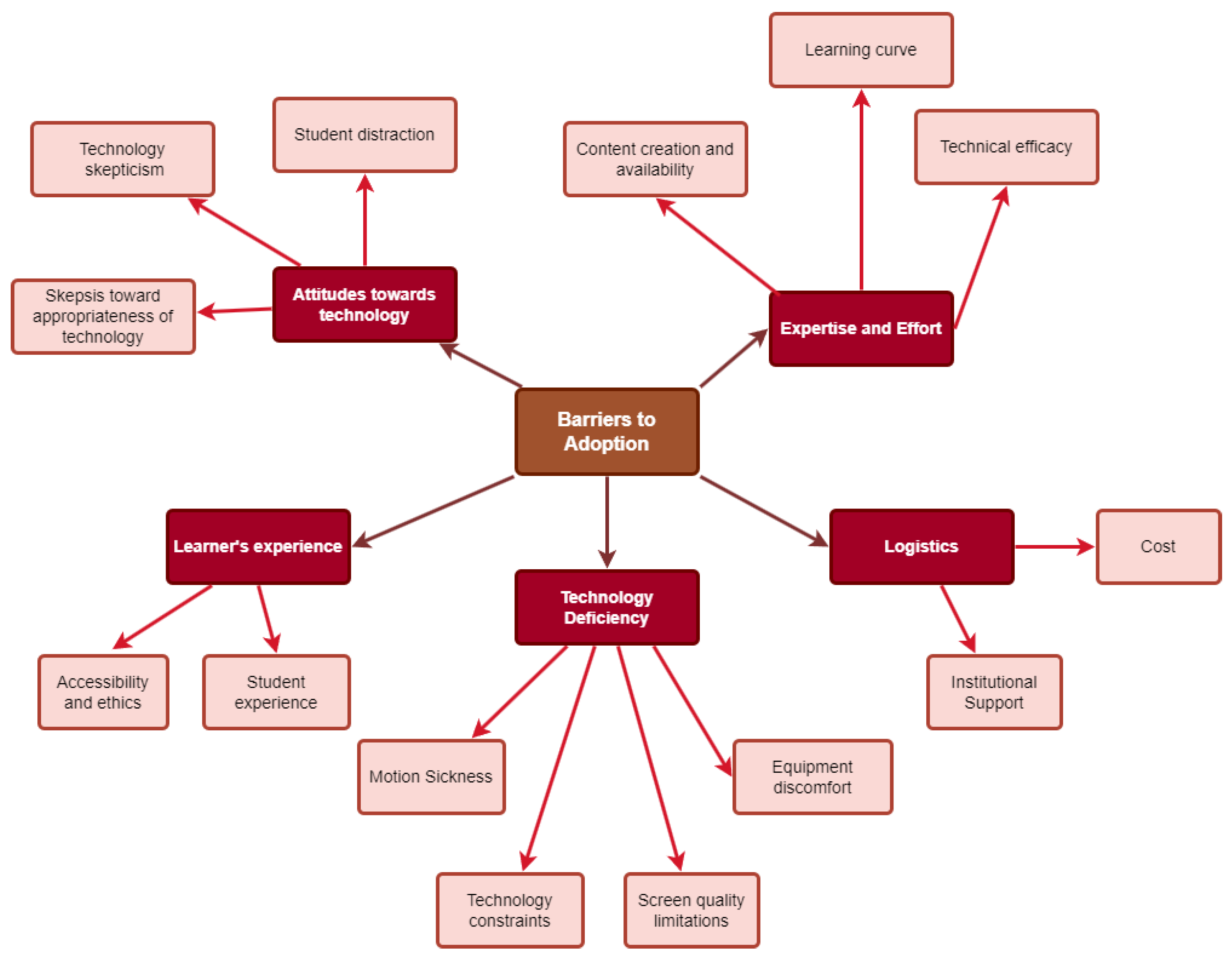
| Delivery | Frequency | ||||
|---|---|---|---|---|---|
| Method | More than 90% of Lectures | More than 60% of Lectures | More than 30% of Lectures | 30% of Lectures or Less | Never |
| Real-time demonstration | 6 | 1 | 4 | 3 | 2 |
| Prepared instruction | 7 | 3 | 1 | 5 | 0 |
| Descriptive Statistic | Pre-Exposure (Mins) | Post-Exposure (Mins) |
|---|---|---|
| Mean | 40 | 48.75 |
| Median | 35 | 50 |
| STDEV | 24.77 | 40.64 |
| MIN | 0 (asynchronous) | 10 |
| MAX | 90 | 180 |
Disclaimer/Publisher’s Note: The statements, opinions and data contained in all publications are solely those of the individual author(s) and contributor(s) and not of MDPI and/or the editor(s). MDPI and/or the editor(s) disclaim responsibility for any injury to people or property resulting from any ideas, methods, instructions or products referred to in the content. |
© 2024 by the authors. Licensee MDPI, Basel, Switzerland. This article is an open access article distributed under the terms and conditions of the Creative Commons Attribution (CC BY) license (https://creativecommons.org/licenses/by/4.0/).
Share and Cite
Rangarajan, V.; Shahbaz Badr, A.; De Amicis, R. Evaluating Virtual Reality in Education: An Analysis of VR through the Instructors’ Lens. Multimodal Technol. Interact. 2024, 8, 72. https://doi.org/10.3390/mti8080072
Rangarajan V, Shahbaz Badr A, De Amicis R. Evaluating Virtual Reality in Education: An Analysis of VR through the Instructors’ Lens. Multimodal Technologies and Interaction. 2024; 8(8):72. https://doi.org/10.3390/mti8080072
Chicago/Turabian StyleRangarajan, Vaishnavi, Arash Shahbaz Badr, and Raffaele De Amicis. 2024. "Evaluating Virtual Reality in Education: An Analysis of VR through the Instructors’ Lens" Multimodal Technologies and Interaction 8, no. 8: 72. https://doi.org/10.3390/mti8080072
APA StyleRangarajan, V., Shahbaz Badr, A., & De Amicis, R. (2024). Evaluating Virtual Reality in Education: An Analysis of VR through the Instructors’ Lens. Multimodal Technologies and Interaction, 8(8), 72. https://doi.org/10.3390/mti8080072







